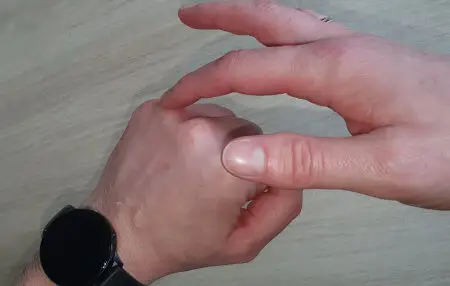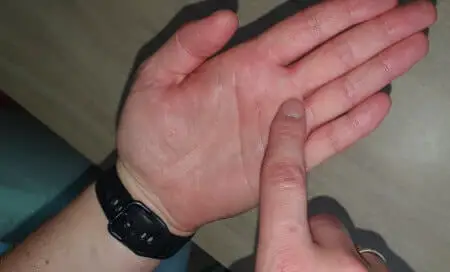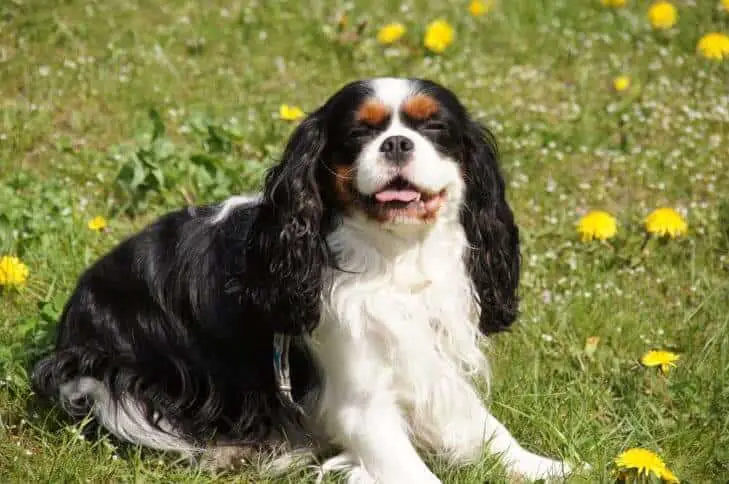I am a delightful parent to a Cavalier King Charles Spaniel, and her health is something I am always concerned with.
My dog is getting a little older. Being overweight is one of my many worries, and older dogs get overweight much easier than young puppies. When my dog was only fully grown, I would often meet another King, Charles Spaniel, bigger than mine in the streets. Female dogs are mostly smaller than males, but it made the other owner sometimes wonder if their Cavalier is big.
So I decided to research and write here about why a Cavalier King Charles can be bigger than the average size or weight.
Why Is Your Cavalier King Charles Spaniel So Big?
When it comes to dogs, we can’t stress enough that size matters! And to keep check of your dog’s size, you must breed familiarity with the factors that cause your dog to become oversized.
Reasons for your Cavalier King Charles Spaniel to become significantly oversized include overeating, consumption of too many treats, excessive calories, and carbohydrates or disproportionate accumulation of fur. If not, genetic health disorders might also be why your Cavalier King Charles Spaniel is gaining excessive weight.
Do Energetic Dogs Become Overweight?
Now many people think that since they own an energetic dog, they are saved from maintaining their health because, well, they do get enough exercise. If you stand in the queue of such people, now is the right time to get your facts right! Running around and playing fetch is, no doubt, an excellent exercise to help dogs stay fit. However, it does not ensure that they won’t go overweight.
In fact, most energetic and playful dog breeds stay fit and healthy as long as they run and play all day until the end of their puppyhood. But the moment they reach adulthood, their weight becomes a significant issue.
Factually, Cavalier King Charles Spaniels also fall in the same category. As soon as they hit adulthood, they crave much more food than their body requires.
The Association for Pet Obesity, United States, backs this statement, declaring that more than half of the US and the UK dogs are overweight. So there are high chances that your Cavalier King Charles Spaniel will be obese.
How to Determine If My Cavalier King Charles Spaniel Is Overweight?
Coming to another relevant concern of Cavalier King Charles Spaniel owners, how can you determine if your Cavalier King Charles Spaniel is overweight?
Now, many people consider that a fat dog is a healthy dog; however, the reality is on the contrary. Think of it this way: is an obese child a healthy child? No! You might be surprised, but the same goes for dogs.
So, How can you determine whether your Cavalier King Charles Spaniel is overweight or not?
The Touch-and-Feel Method
It’s pretty simple! You can effortlessly determine whether your Cavalier King Charles Spaniel is underweight, overweight, or just the right size by running your fingers across his sides.
- If you feel its ribs sticking out, your Cavalier King Charles Spaniel is underweight.

Make a fist of one hand and lightly feel over your knuckles with the other hand. Imagine your knuckles being your dog’s ribs. This is how it would feel when your dog is underweight. - If you can’t see his ribs sticking out, but can feel them without having to push in, then your Cavalier King Charles Spaniel is the perfect figure.

Open your hand, palm down. Run your fingers over your knuckles. This is how your dog’s ribs would feel if his weight is just right. - If you have to force your way in its fur to feel his ribs, then your Cavalier King Charles Spaniel is overweight.

Open your hand palm up and fingers straight. With your other hand, run your fingers over the base of your hand. Now you have an idea how your dog’s ribs would feel if he is too heavy.
This was the physical method. But keeping in mind the mischievous nature of the doggo, you might face some difficulty getting it to allow you to complete your check. So, what you can do in this case is to examine your Cavalier King Charles Spaniel from above.
The Eye-Ball-It Method
Simply stand on a chair or at a height and observe your Cavalier King Charles Spaniel from aerial view. From the bird’s eye view, your Cavalier King Charles Spaniel should have an hourglass figure. Minimal abdominal fat and a noticeable waist indicate a fit Cavalier King Charles Spaniel.
Suppose you can’t see his ribs and feel an excessive layer of fat over them. In that case, you can ascertain that your Cavalier King Charles Spaniel is overweight. Likewise, if you can see his ribs sticking out, then the dog is underweight.
What Is the Average Size of a Fully Grown Cavalier King Charles Spaniel?
Now that you know the two easiest methods of determining whether your Cavalier King Charles Spaniel is overweight or not, you must be wondering what the size of your Cavalier King Charles Spaniel should be in his healthiest state.
The difference in the size of a Cavalier King Charles Spaniel varies minutely with its gender, unlike many other dog breeds. The difference arises in their build: while male Cavalier King Charles Spaniels have a noticeably bigger form and more muscles mass, female Cavaliers have a slightly slimmer body with less muscle mass.
Stated below is the average weight and size of both a male and a female Cavalier King Charles Spaniel:
| Male Cavalier King Charles Spaniel | Female Cavalier King Charles Spaniel | |
|
|
|
|
|
|
By taking a look at the above stats and comparing them with your doggo, you can determine whether your Cavalier King Charles Spaniel is too big or not. Of course, this is an average.
Some cavaliers can be bigger in height, and in this case, they can also weigh more than average. I want to refer you to the earlier mentioned methods to determine if your dog is overweight.
Moreover, you can get an estimate of how much work you’ll have to put into your Cavalier King Charles Spaniel for it to attain the ideal size.
At What Age Are Cavalier King Charles Spaniel Fully Grown?
New Cavalier King Charles Spaniel owners pay close attention! There is one more thing as necessary as determining whether your Cavalier King Charles Spaniel is obese or not. And that is to define it at the right time.
If your dog hasn’t matured yet, and you comprehend that its weight is less than the average, and you start feeding it more, you are just torturing the poor creature. Why? Because it’s normal for pups to have fluctuating weights! So, if you are feeding it more now, you are putting in all your efforts to make it obese in the future.
So, it is necessary to know the age when your Cavalier King Charles Spaniel will have the maximum potential to be fully grown. Cavaliers generally mature around 12 months and reach their potential weight and size between the age of 18 to 24 months. This is the right time for you to determine whether yours is obese or not.
What Can Cause My Cavalier King Charles Spaniel to be So Big?
We stated the main reasons that caused Cavalier King Charles Spaniels to gain excessive weight above, but now is the time to go in-depth. Here are some of the reasons why your Cavalier King Charles Spaniel is bigger than the rest of its family:
1- Overfeeding
Feeding the Cavalier King Charles Spaniel more than its body requires is the most common reason to gain excessive weight. A full-grown Cavalier should eat between 120grams and 180grams of food per day, and the best is to divide this over two meals a day.
If you measure this, you will see it is not much, and it can quickly add up when you feed your dog treats during the day.
2- Matting
Another common reason for Cavalier King Charles Spaniel to be gaining excess weight is matting. When an animal’s fur coat is not removed, it gets tangled, and it develops clumps that look like fat accumulation but aren’t! Dog owners usually think that obesity is why their dogs are bigger than their counterparts, while the actual problem is improper grooming.
You should groom your doggy at least twice a week minimum and, Remove all tangles. When you often walk your dog outside in the countryside, you should brush your dog more often. It’s best is to brush your dog every time you come home to remove all debris from his coat.
Grooming your King Charles also helps prevent excessive shedding. You can read more about shedding and King Charles Spaniels here.
3- Lack of exercise
Like the Cavalier King Charles Spaniel, indoor dogs are at a higher risk of being exposed to obesity if not taken out for regular walks. The King Charles spaniel is an energetic dog activity. This dog loves to play, run and please his owner and tends to do well with agility. The cavalier needs about an hour of activity every day, including running.
I have written a great article about going outside with your dog when it snows. You can read it here.
The lack of exercise does not prevent your Cavalier from growing too big in size. However, it influences the development of muscle and bones, affecting his health later in his life.
4- Genetic Tendency
Some dog breeds tend to become overweight as a genetic condition. These include terrier breeds, Labrador retrievers, beagles, dachshunds, and of course, the Cavalier King Charles Spaniels.
The problem is our King Charleses just love to eat. We, as a parent, need to be strong and not fall for the sad puppy eyes.
This breed is also susceptible to heart problems, and it can worsen when they gain weight, so we need to be extra careful not to feed them too much.
You can look at point one, overfeeding, to see how much an adult Cavalier needs to eat.
5- Neutering / Spaying
Dogs that undergo surgeries such as spaying tend to drain more energy due to hormonal changes, which, as a result, increases their hunger, leading them to gain excess weight.
6- Medications
Suppose your Cavalier King Charles Spaniel has regular usage of certain medicines like Phenobarbital and Glucocorticoids. In that case, there are chances of him developing an increased hunger.
7- Diseases
Other than that, various health disorders like hypothyroidism, hyperadrenocorticism, and insulinoma also contribute to Cavalier King Charles Spaniels gaining weight.
Be aware that medication or disease can influence his hunger or biorhythm. Control yourself for a proper diet so you are pub received Oldham fishing to me and won’t grow too big.
What Are the Signs That My Cavalier King Charles Spaniel is Too Fat?
While many signs signify that your Cavalier King Charles Spaniel has gained excessive weight, here are some of the most accurate ones:
1- No Visible Rib cage and Waistline
Cavalier King Charles Spaniels should have such a figure that their chest and ribcage amalgamates into a waistline just above their hip bones. If you can’t tell where the ribcage ends, and the hipbone begins, and where the waist falls, then your Cavalier King Charles Spaniel is probably too fat.
Tip: A thick coat could make it hard to see the rib cage and waistline. Have a look after you showered your dog and before you dry him. When the wet hair is tight to the body, it is easier to see the waistline.
2- Excessive Body Fat
Suppose your Cavalier King Charles Spaniel is having a tough time reaching his ear to scratch. In that case, it is apparent that the furry fellow has become a fatty fellow.
3- Distended Abdomen
Having a distended abdomen is also a significant sign of your Cavalier King Charles Spaniel being overweight. How to make out whether your Cavalier King Charles Spaniel has a distended abdomen, you ask? Move your hand around your Cavalier’s tummy. If it exerts an uncomfortable sensation or seems to be in pain, that’s your clue!
The best thing to do is consult a vet to figure out what could cause the distended abdomen.
4- No Self-Grooming
Dogs and Cavalier King Charles Spaniels, in particular, love to groom themselves. Suppose your Cavalier King Charles Spaniel is having difficulty grooming itself due to its excessively round body figure. In that case, you can pass an order that it is time for diet control.
5- Lack of Mobility
If your walking enthusiast Cavalier resists going to the park or starts panting mid-way, then don’t be surprised, and more importantly, don’t push him into exercising! Because lack of mobility is yet another sign that your Cavalier King Charles Spaniel has gained more weight than it should have.
Shorten the walks or take a shorter walk in the morning and another in the evening. Walk him every day and build up from there, but don’t overdo it.
6- Lethargy
Is your once so-active Cavalier King Charles Spaniel lying idle? Don’t divert your attention to any other cause, because being overweight is one of the primary reasons that make Jack a dull boy.
7- Difficulty Breathing
While this symptom appears once in a blue moon, it indicates that the situation is severe when it does. So, suppose you ever notice your Cavalier King Charles Spaniel having difficulty breathing even in a favorable environment. In that case, it is time to take it to a vet!
What Can I Do to Help My Cavalier King Charles Spaniel Lose Weight?
Now that you know of all the possible reasons for your Cavalier King Charles Spaniel to gain excessive weight and the symptoms to identify it. It is time to learn what you can do to help the poor fellow in attaining the perfect figure:
1- Brush his Coat Regularly
The first step: brush your Cavalier King Charles Spaniel fur coat at least twice a week to ensure that it is obesity and not matting that is causing excessive weight put-on.
2- Keep it Active
Set timings to take it out on walks, play ‘fetch”, and make him run as much as possible to help develop high stamina.
Let him off leash for at least half of the time you are outside with him.
3- Don’t Fall for the Cute Puppy Face
No matter how cute your Cavalier King Charles Spaniel looks while asking for treats, don’t give in! Draw a line between hunger and begging, make a routine for feeding the dog and stick to it to ensure that your Cavalier King Charles Spaniel doesn’t outsize its pants (if they have any for dogs, that is).
4- Limit Treats
Don’t, I repeat, don’t give your dog voluntary treats. Think of treats and table scraps as candy for children. You would want them to have the least intake, wouldn’t you?
Use treats for training and put it away after the session is over. Calculate the number of treats into his diet. Lower the amount of food you give him in the morning or evening if you must.
5- Cut Down on Carbs
Switch your Cavalier King Charles Spaniel to healthier food options. Cut on excessive carbohydrates and calories. Try replacing sweet treats like biscuits and fatty substances like cheese with healthier alternatives. Try chopped or sliced carrots, apples, and green beans, for instance! Figure you what your dog loves, and you can use that as a training treat.
6- Consult a Vet
If your Cavalier’s weight doesn’t seem to be controlled even after following all the above-listed precautions, book an appointment with the vet! Get your Cavalier King Charles Spaniel checked, consult with the doctor and create a customized diet plan that suits your dog.
Conclusion
This article should act as a guide for all those toy breed owners who are struggling to maintain their Cavalier King Charles Spaniel’s weights. So, whether you own a Cavalier or not, it is always recommended to keep a check on the average size of your particular breed and keep your dog’s weight around that.
Have any other suggestions for new Cavalier owners to help them in reducing their doggie’s weight? Please feel free to share them in the comments. Adios!

